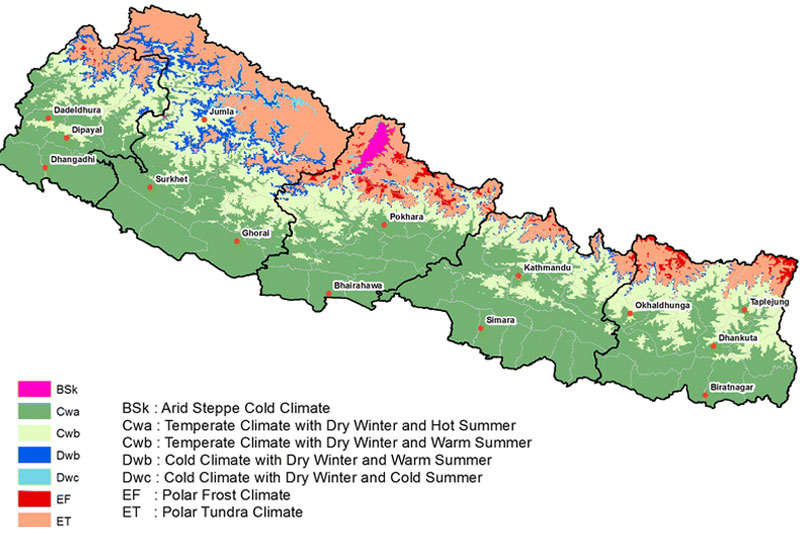Nepal, nestled in the breathtaking Himalayas, boasts a diverse and enchanting climate that will leave you awestruck. From the subtropical lowlands in the Terai region to the chilly and snow-clad peaks of the mountains, Nepal offers a climatic mosaic that caters to every traveler’s preference.
With five distinct seasons and variations in temperature, precipitation, and landscape, this article will unravel the captivating climate of Nepal, inviting you to embark on an extraordinary journey filled with mesmerizing landscapes and unforgettable experiences.
Background
Nepal, a beautiful country situated in South Asia, is known for its diverse geographical features and breathtaking landscapes. It is nestled between two giants, China and India, which greatly influence its climate. Let’s dive into the details of Nepal’s climate and explore the various seasons and weather phenomena that make this country unique.
Geographical Location
Nepal is located in the Himalayas, with its southern borders stretching along the Gangetic plains. The country is landlocked and lies between 80.12°E and 88.15°E longitudes, and 26.22°N and 30.27°N latitudes. This strategic location between the towering mountains and the vast plains significantly impacts Nepal’s weather patterns.
Topography
Nepal’s topography is incredibly diverse due to its unique positioning. It stretches from the low-lying Terai region in the south, with fertile plains and marshlands, to the majestic Himalayan mountain range in the north, including Mount Everest, the highest peak in the world. Alongside the mountains, there are terraced hills and valleys, each contributing to the various climatic zones within the country.
Seasons
Nepal experiences four distinct seasons: Monsoon, Winter, Summer, and Spring. Each season has its own characteristics and impact on the climate, flora, and fauna of the country. Let’s explore these seasons more deeply.

Monsoon Season
Duration
The monsoon season, also known as the rainy season, typically lasts from June to September in Nepal. This is the period when the country receives the highest amount of rainfall throughout the year.
Effect on Climate
During the monsoon season, Nepal experiences a significant increase in humidity levels. The air becomes heavy with moisture, creating a feeling of dampness in the environment. This increased humidity combined with the rainfall leads to a cooler climate, providing relief from the scorching heat of the preceding summer season.
Rainfall Patterns
The monsoon season brings abundant rainfall to Nepal, filling its rivers and lakes and nourishing its lush forests and agricultural fields. The rainfall patterns vary across the country, with the Terai region receiving the highest amount of precipitation, followed by the hilly areas, and finally the mountainous regions.
Winter Season
Duration
Winter in Nepal typically spans from December to February, with January being the coldest month. This season is characterized by chilly temperatures and clear skies.
Temperature
Temperatures during winter can drop significantly, especially in higher altitude areas. In the Terai region, temperatures range from 7°C to 23°C (45°F to 73°F), while in the mountainous regions, temperatures can plunge below freezing.
Snowfall
With the arrival of winter, snowfall becomes a common occurrence in the higher elevations, including the popular trekking destinations like Everest Base Camp and Annapurna Circuit. The snow-capped peaks and picturesque landscapes attract tourists from around the world, making it a great time to explore Nepal’s mountainous beauty.
Summer Season
Duration
Summer in Nepal extends from May to August, overlapping with the monsoon season. It is characterized by warm temperatures and intermittent rain showers.
Temperature
Nepal experiences relatively high temperatures during summer, with the Terai region recording temperatures ranging from 25°C to 40°C (77°F to 104°F). In the hilly and mountainous regions, temperatures are milder, providing relief from the scorching heat.
Pre-monsoon Showers
As summer progresses and the monsoon approaches, Nepal witnesses pre-monsoon showers. These showers offer a taste of the upcoming rainy season, providing some respite from the heat while signaling the approaching change in weather.
Spring Season
Duration
Spring in Nepal spans from March to May. It is considered the most pleasant season of the year, with moderate temperatures and blooming landscapes.
Temperature
Temperatures during spring are mild and comfortable, making it an ideal time for outdoor activities and exploration. In the Terai region, temperatures range from 20°C to 30°C (68°F to 86°F), while in the higher elevations, temperatures vary but remain pleasant.
Blooming Period
Spring is a magical time in Nepal when nature awakens from its winter slumber. The hills and valleys come alive with colorful flowers, including the famous rhododendrons, which blanket the mountains in vibrant hues. The blooming period provides stunning landscapes and a unique experience for travelers.
Autumn Season
Duration
Autumn in Nepal stretches from September to November. Known as the harvest season, it is considered the best time to visit the country due to its favorable weather conditions.
Temperature
During autumn, the temperatures in Nepal are mild and stable, neither too hot nor too cold. In the Terai region, temperatures range from 15°C to 30°C (59°F to 86°F), while in the mountainous regions, temperatures are cooler but still comfortable for outdoor activities.
Harvest Season
Autumn in Nepal marks the harvest of crops such as rice, maize, and millet. The fields are adorned with golden grains, and festivals such as Dashain and Tihar celebrate the bounty of the land. The clear skies and pleasant weather make autumn an ideal time to explore Nepal’s cultural heritage and natural beauty.
Impact of Altitude
Decreasing Temperature with Altitude
As one ascends the mountains in Nepal, the temperature gradually decreases due to the change in altitude. This variation in temperature with altitude creates diverse microclimates and vegetation zones in the mountainous regions.
Microclimates in Mountainous Regions
Nepal’s mountainous regions boast a range of microclimates, each supporting distinct flora and fauna. The lower regions exhibit subtropical climates with lush forests and diverse wildlife, while the higher elevations transition into alpine climates, characterized by sparse vegetation and harsh weather conditions.
Climate Zones
Nepal can be divided into four main climate zones, each with its own unique characteristics and climatic conditions.
Tropical Zone
The Terai region falls under the tropical zone, characterized by hot and humid summers and mild winters. This region receives high annual rainfall and supports dense forests and diverse wildlife.
Subtropical Zone
The subtropical zone extends from the Terai region to the Siwalik Hills. It experiences milder temperatures compared to the tropical zone and is known for its fertile soil and agricultural productivity.
Temperate Zone
The temperate zone includes the hilly regions of Nepal and experiences moderate temperatures throughout the year. This zone is known for its picturesque landscapes, rich biodiversity, and cultural heritage.
Alpine Zone
The alpine zone encompasses the high Himalayan ranges of Nepal, where temperatures are cold, and vegetation is sparse. This zone is home to the world’s highest peaks and attracts mountaineers and adventurers from around the globe.
Climate Change
Nepal, like many other countries around the world, is grappling with the effects of climate change. The changing climate patterns in Nepal have significant implications for its environment, economy, and communities.
Increasing Temperatures
Nepal has been witnessing a gradual increase in temperatures over the past few decades. This rise in temperatures affects various aspects of life, including agriculture, water resources, and overall ecosystem balance.
Changing Rainfall Patterns
The rainfall patterns in Nepal are also undergoing changes due to climate change. Increased frequency and intensity of rainfall events, coupled with prolonged dry periods, pose challenges for water availability and agricultural practices.
Glacial Retreat
The Himalayan glaciers in Nepal are highly sensitive to climate change. Rising temperatures have led to the retreat of these glaciers, impacting water resources, hydropower generation, and ecosystem dynamics. The loss of these glaciers also poses long-term challenges for the region’s water security.
Weather Phenomena
Nepal experiences various weather phenomena that add to its climate’s charm and uniqueness. Let’s explore some of these phenomena.
Thunderstorms
During the monsoon season, Nepal witnesses spectacular thunderstorms. The combination of heat, humidity, and atmospheric instability leads to the formation of thunderclouds, resulting in dramatic lightning displays and thunderous booms.
Hailstorms
Hailstorms are occasional occurrences in Nepal, particularly during spring and summer. These weather events bring hailstones of different sizes, creating a fascinating display of nature’s power.
Fog
Fog is a common occurrence, especially in the Terai region, during the winter months. It creates a mystical ambiance, with landscapes often shrouded in mist, enhancing the beauty of Nepal’s plains and valleys.
In conclusion, Nepal’s climate is as diverse as its landscapes. From the monsoon season that brings life-giving rainfall to the snowy winters and blooming springs, the country experiences distinct seasons that greatly impact its natural beauty and cultural traditions.
The mountainous terrain and varying altitudes create a range of microclimates, while climate change poses new challenges. Understanding Nepal’s climate not only enriches our knowledge but also provides valuable insights into the delicate balance of nature and the need for sustainable practices to ensure a harmonious future.
